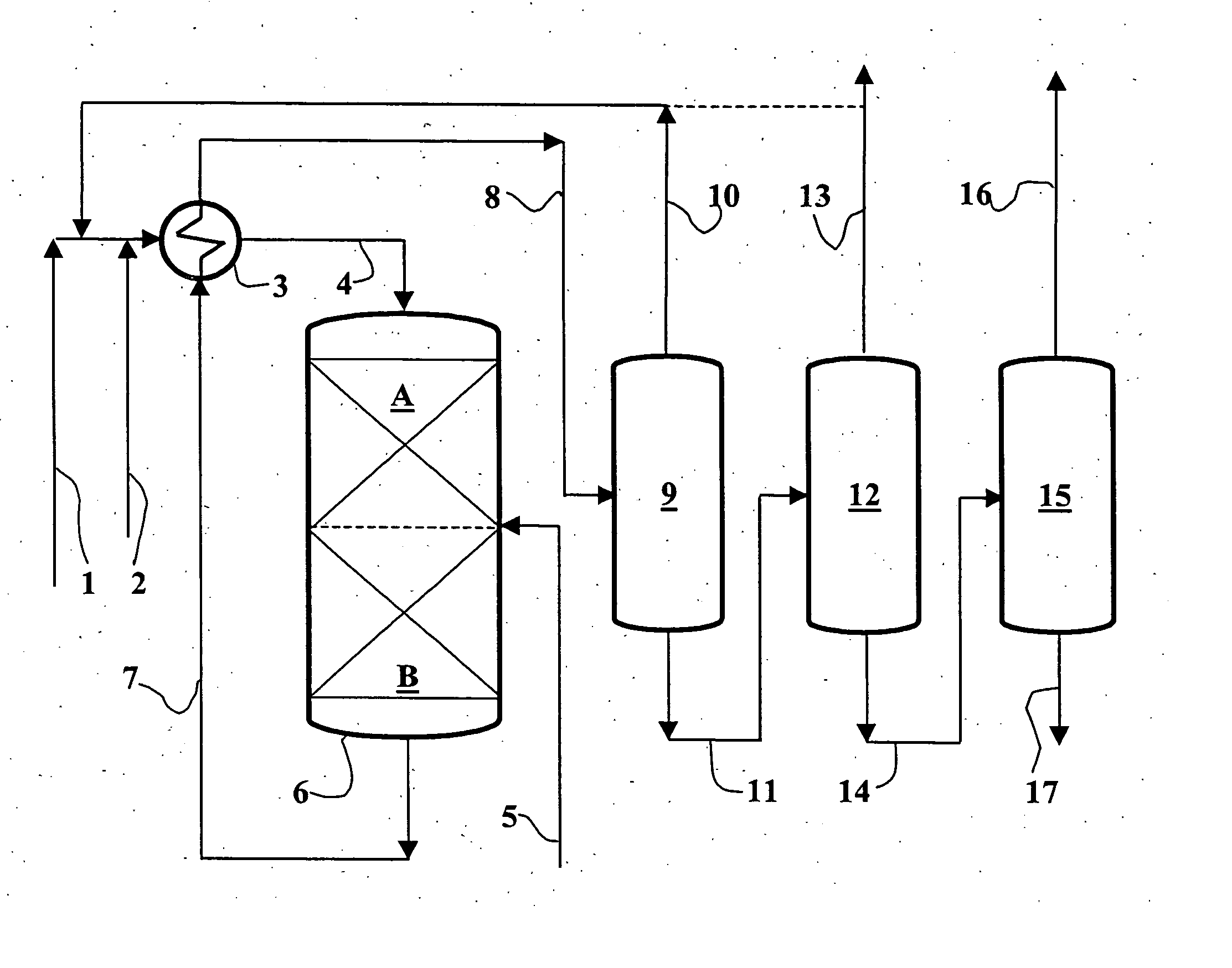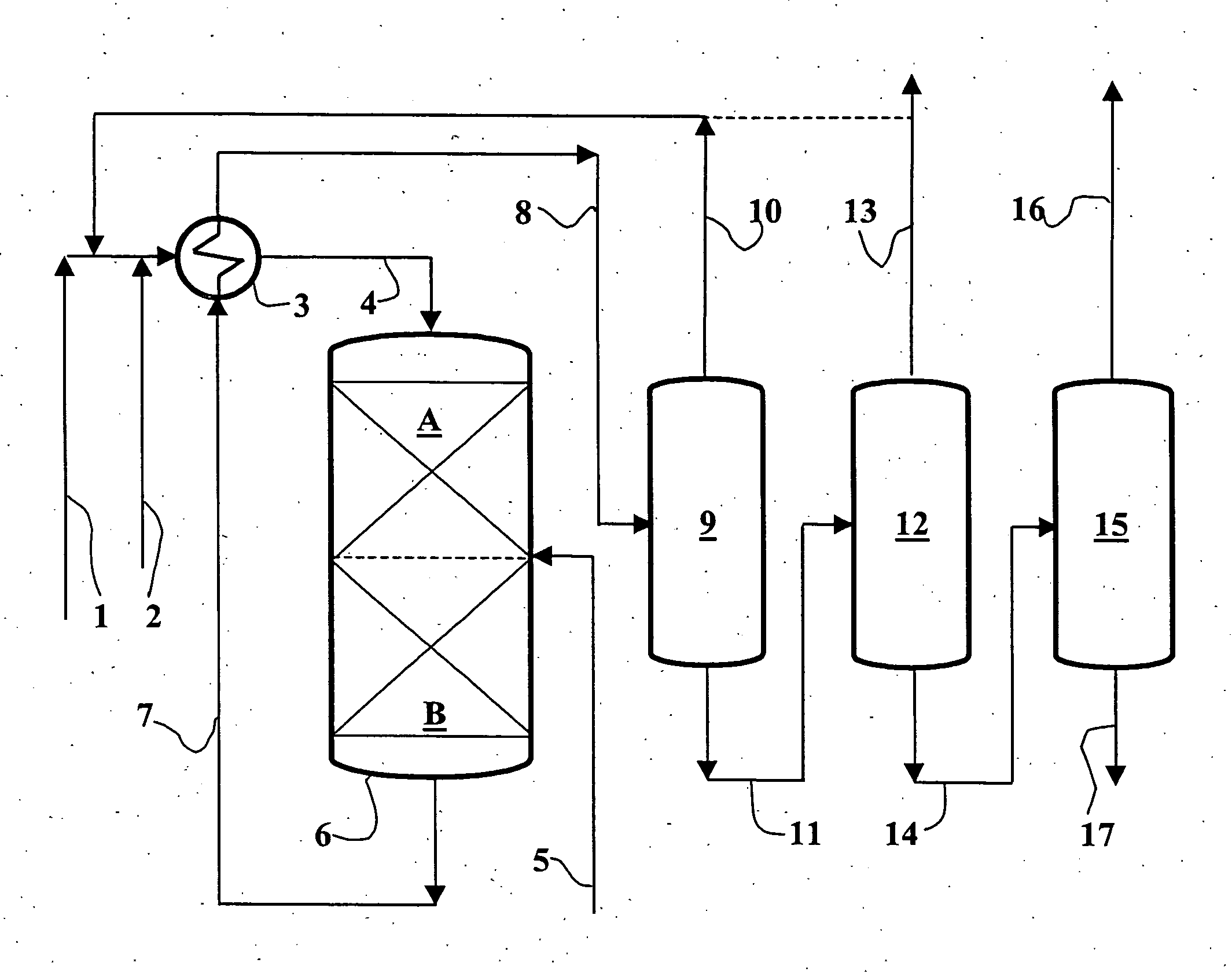Process for the production of phenylalkanes in the presence of a solid acid catalyst the deactivation of which is delayed
- Summary
- Abstract
- Description
- Claims
- Application Information
AI Technical Summary
Benefits of technology
Problems solved by technology
Method used
Image
Examples
example 2
Preparation of Catalyst B Containing a Mordenite Zeolite
[0042] A mordenite zeolite in sodium form is used, the chemical formula of which in the hydride state is NaAlO.sub.2(SiO.sub.2).sub.5,1, and its sodium content is 5% by weight. 100 grams of this powder are taken to reflux at 100.degree. C. for 2 hours in a solution of 4N ammonium nitrate with a V / W ratio equal to 4 cm.sup.3 / g. This cation exchange operation is repeated 3 times. The sodium content by weight of the product obtained is approximately 500 ppm (part per million).
[0043] This product is then subjected to an acid attack using an aqueous solution of 4.5N nitric acid, the product is taken to reflux in this aqueous solution for 2 hours with a V / W ratio equal to 4 cm.sup.3 / g. After this treatment, the product is washed in demineralized water.
[0044] The mordenite obtained has an Si / Al atomic ratio equal to 40 and a sodium content equal to 20 ppm by weight.
[0045] The mordenite thus obtained is then mixed with an alumina gel (...
example 3
Alkylation of Benzene by 1-dodecene in the Presence of Catalyst A (Not According to the Invention)
[0046] A catalytic reactor is used, comprising only one reaction zone containing 50 cm.sup.3 of catalyst A in the form of extrudates, prepared according to Example 1. The operating conditions for the alkylation of the benzene by 1-dodecene are the following:
[0047] temperature: 135.degree. C.
[0048] pressure: 4 MPa
[0049] HVR=1 h.sup.1 (cm.sup.3 benzene+1-dodecene charge per cm.sup.3 of catalyst and per hour)
[0050] benzene / 1-dodecene molar ratio: 30
[0051] A charge is prepared containing 72% by weight of benzene and 28% by weight of 1-dodecene. This charge is introduced at the inlet to the catalytic reactor where the alkylation reaction is carried out. The results obtained are presented in Table 1.
1 TABLE 1 Duration of cycle with conversion of the olefin > 95% 15 h Linearity of the product obtained (% by weight) 92.8 2-phenylalkane 27.1 3-phenylalkane 22.3 4-phenylalkane 19.4 5-phenylalkane...
example 4
Alkylation of Benzene by 1-dodecene in the Presence of Catalyst A (According to the Invention)
[0053] A catalytic reactor is used, in which two reaction zones are present each containing 25 cm.sup.3 of catalyst A in the form of extrudates, prepared according to Example 1.
[0054] The operating conditions for the alkylation of the benzene by 1-dodecene are the following:
[0055] temperature: 135.degree. C.
[0056] pressure: 4 MPa
[0057] HVR=1 h.sup.-1 (cm.sup.3 benzene+1-dodecene charge per cm.sup.3 of catalyst and per hour)
[0058] benzene / 1-dodecene molar ratio: 30
[0059] A charge is prepared containing 86% by weight of benzene and 14% by weight of 1-dodecene. This charge which is introduced at the inlet to the first reaction zone contains all of the benzene necessary for the alkylation reaction and half of the quantity of 1-dodecene necessary for the alkylation reaction. The other half, corresponding to a quantity of 1-dodecene identical to that present in the charge introduced at the inlet ...
PUM
| Property | Measurement | Unit |
|---|---|---|
| Fraction | aaaaa | aaaaa |
| Fraction | aaaaa | aaaaa |
| Ratio | aaaaa | aaaaa |
Abstract
Description
Claims
Application Information
 Login to View More
Login to View More - R&D
- Intellectual Property
- Life Sciences
- Materials
- Tech Scout
- Unparalleled Data Quality
- Higher Quality Content
- 60% Fewer Hallucinations
Browse by: Latest US Patents, China's latest patents, Technical Efficacy Thesaurus, Application Domain, Technology Topic, Popular Technical Reports.
© 2025 PatSnap. All rights reserved.Legal|Privacy policy|Modern Slavery Act Transparency Statement|Sitemap|About US| Contact US: help@patsnap.com


